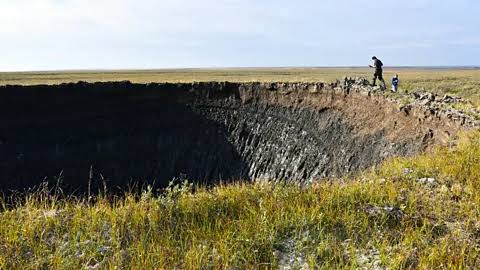Researchers have finally solved the mystery behind the massive craters appearing in Siberia. Surprisingly, these enormous pits, some as deep as 165 feet (50 meters), are directly linked to climate change and the explosive release of methane gas trapped beneath the surface.
Discovery of Siberia’s Mysterious Craters
The first of these craters was discovered in 2014 on the Yamal Peninsula, a remote region in Siberia. Since then, several more have been spotted, leaving scientists baffled. Early theories suggested the craters were caused by underground explosions, but the exact cause remained unclear—until now.
Methane Gas: The Explosive Culprit
High levels of methane, a potent greenhouse gas, detected in the region led scientists to believe that rising temperatures were responsible for its release. The Siberian permafrost, which holds vast amounts of methane, is thawing as global temperatures rise. However, researchers soon realized that permafrost thaw alone couldn’t trigger the violent explosions behind these craters.
New Research Reveals the True Cause
A team of chemical engineers recently published groundbreaking research in Geophysical Research Letters. Led by Ana Morgado, a chemical engineer from the University of Cambridge, the study revealed that the craters are the result of rapid underground pressure changes.
“There are very, very specific conditions that allow for this phenomenon to happen,” Morgado explained in a press release. “We’re talking about a very niche geological space.”
The Role of Cryopegs and Permafrost Layers
The researchers focused on the geological makeup surrounding the craters and ruled out chemical reactions as the cause. Beneath the permafrost lies a unique geological layer called cryopegs, which contains salt and remains unfrozen even in subzero temperatures. These cryopegs, which are about three feet thick and lie as deep as 165 feet underground, are layered with crystallized methane.
How Climate Change Triggers Explosive Methane Eruptions
For thousands of years, these layers have remained stable. But since the 1980s, rising global temperatures have begun altering this delicate balance. The warming climate causes the topsoil to thaw and refreeze, allowing water to seep deeper into the ground, reaching the cryopegs. This infiltration causes a dangerous buildup of pressure.
As the pressure in the cryopegs increases, cracks form on the surface, which leads to a rapid drop in pressure. The trapped methane gas then forcefully erupts, causing an explosion and forming the mysterious craters.
The Bigger Picture: Climate Change and Methane
The discovery of these explosive methane craters serves as a stark reminder of the far-reaching impacts of climate change. Methane, a greenhouse gas, is 25 times more effective at trapping heat in the atmosphere than carbon dioxide, meaning these eruptions could accelerate global warming even further.
Conclusion: A Wake-Up Call
The appearance of these craters is a clear indication that global warming is affecting Earth’s subsurface layers in ways we are just beginning to understand. The release of methane from permafrost regions like Siberia could have dire consequences for our climate, further driving the need for urgent action.
Stay updated with the latest climate change discoveries and learn how they could impact the future of our planet. Subscribe to our newsletter and follow us for more in-depth analyses and environmental news.



